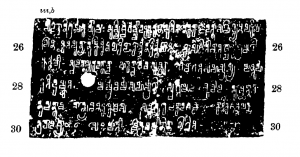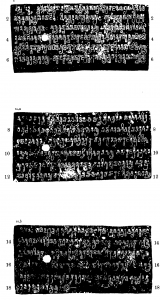

| Metadata | |
|---|---|
| Inscription ID | IN00161 |
| Title | Belora Charter Fragment B3 of Pravarasena II |
| Alternative titles | Belora Plates of Pravarasena II |
| Parent Object | OB00148 |
| Related Inscriptions | IN00158 IN00159 IN00160 |
| Responsibility | |
| Author | Dániel Balogh |
| Print edition recorded by | Dániel Balogh |
| Source encoded | |
| Digitally edited by | |
| Edition improved by | Dániel Balogh |
| Authority for | Own research. |
| Metadata recorded by | Dániel Balogh |
| Authority for metadata | |
| Metadata improved by | |
| Authoriy for improved | |
| Language | संस्कृतम् |
| Reigning monarch | |
| Commissioner | |
| Topic | |
| Date: | |
| Min | 421 |
| Max | 436 |
| Comment | Intrinsic Date: 11 kārttika śukla 13 (era: regnal, Pravarasena II of Nandivardhana). Basis of dating: approximate reign of Pravarasena II of the Pravarapura/Nandivardhana branch. |
| Hand | |
| Letter size | 0.5 |
| Description | southern box-headed |
| Layout | |
| Campus: | |
| Width | 24 |
| Height | 11.8 |
| Description | Inscribed with 6 lines on each face. Well preserved. Campus and character dimensions are estimates. Traces of a hammered-out earlier inscription (in the same script) can be made out in some places. |
| Decoration | None. |
| Bibliography | |
| References | First reported and edited in Mirashi 1937-38. Discussed in Shastri 1997: 13-16. |
| Add to bibliography | |
| Misc notes | Inscriptions IN00158, IN00159, IN00160 and IN00161 (on objects OB00145, OB00146, OB00147 and OB00148 respectively) were found together as a set; three or more of these four fragments probably form a single text. The first two plates are identical in size; the second two are slightly smaller and again identical to one another, as reported by Mirashi (Mirashi 1937-38: 260, Mirashi 1963: 16). IN00158 is the beginning of a charter with a partial genealogy; IN00159 and IN00160 both continue the genealogy at the point where IN00158 ends, and contain an executive part; IN00161 is the concluding part of a charter, which may continue either of the two alternative middle plates. The executive part in IN00159 and IN00160 is largely identical; the same donee is granted one village in IN00159 and the same village plus another one in IN00160. The charter, dating to the 11th year of Pravarasena II reign, records the donation of the village Mahallalāṭa (in IN00159) and the villages of Mahallalāṭa and Pākkaṇarāshṭra (in IN00160) to Sūryasvāmin.
Mirashi (Mirashi 1937-38: 260-262, Mirashi 1963: 16-17) believes the four plates form two incomplete sets, the text of set B (IN00160 and IN00161) reiterating the grant made in set A (IN00158 and IN00159). His grounds for this assumption is the different size of the plates in the two sets. However, N. P. Chakravarti (editorial note in Mirashi 1937-38: 262n6, summarised in Mirashi 1963: 17n2) proposes that A1, B2 and B3 (i.e. IN00158, IN00160 and IN00161) form an original set, but the grant of two villages “was found to be wrong on examination” and plate A2 (IN00159) was issued to replace B2 (IN00160). His grounds for his hypothesis is that A2 (with slightly shorter text than B2) ends with the last line less than full and marks the end of the text with an ornamental sign, presumably meant to forestall unauthorised additions to the remaining empty space. He admits that he has no explanation why plate A2 was not destroyed, proposing that perhaps none of these plates were ever actually issued, nor were they ever connected with a ring and seal.
Mirashi reiterates his earlier opinion in Mirashi 1963. However, Shastri 1997: 15-16 goes further along Chakravarti’s line of thinking and deems the plates to be “clear-out forgery with official connivance”, thinking that the “avaricious donee” was allowed to retain the wrongly inscribed plate with the double grant even after the error was detected and corrected.
I find none of these hypotheses convincing. If Mirashi were right and these were two grants made at disparate times, then the formerly granted village would in my opinion have been described as such in the second. Mirashi’s observation about plate size may be important but should, if at all possible, be re-checked; also, the half-empty last line of plate A2 is a very convincing indication that this plate is a later replacement for B2. However, if the plates were never issued but retained at the royal chancery as Chakravarti proposed, we would need some very good explanation why these four and no others were found together (also, they would probably have been re-used once again in this case). Similarly, if plate B2 were an illegitimately retained mistaken version as Shastri suggests, then any fraudulent donee with half a set of wits would have melted down plate A2. I have no solution to the puzzle, so I edit each plate as a separate document. |